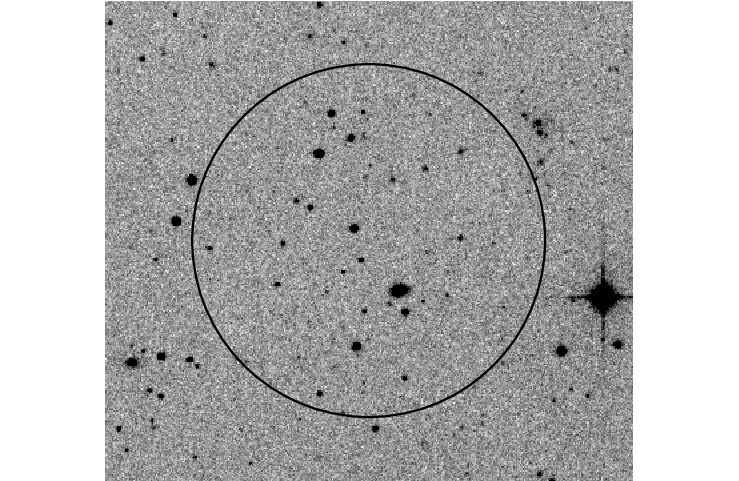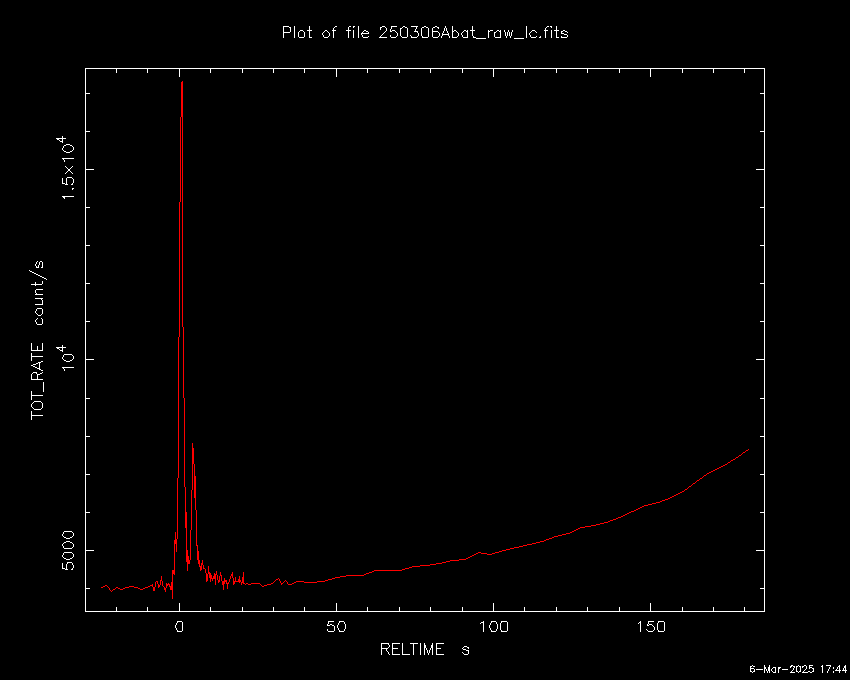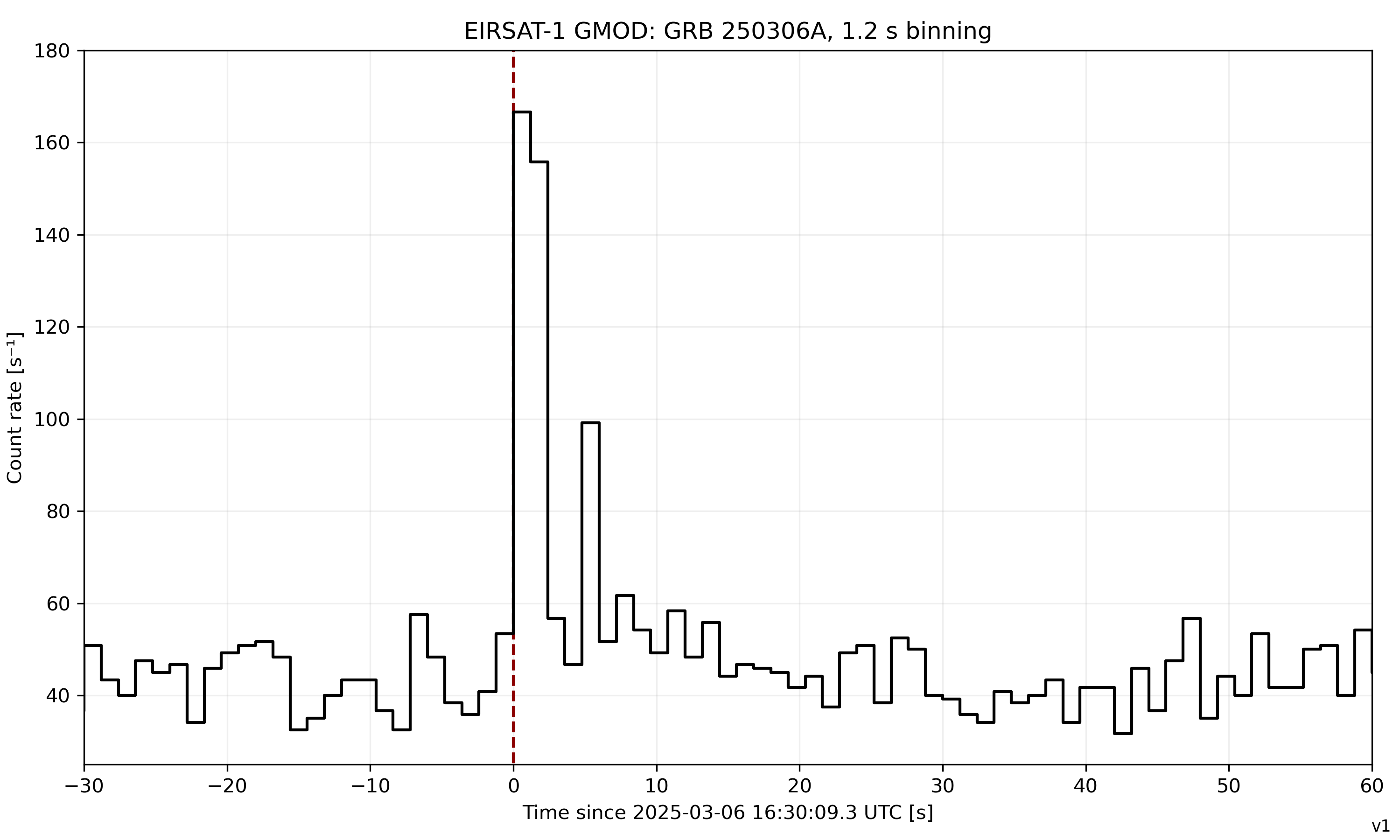- GCN/BACODINE POSITION NOTICE
TITLE: GCN/SWIFT NOTICE
NOTICE_DATE: Thu 06 Mar 25 16:43:33 UT
NOTICE_TYPE: Swift-BAT GRB Position
TRIGGER_NUM: 1293340, Seg_Num: 0
GRB_RA: 354.730d {+23h 38m 55s} (J2000),
355.066d {+23h 40m 16s} (current),
354.059d {+23h 36m 14s} (1950)
GRB_DEC: -47.993d {-47d 59' 35"} (J2000),
-47.854d {-47d 51' 12"} (current),
-48.270d {-48d 16' 12"} (1950)
GRB_ERROR: 3.00 [arcmin radius, statistical only]
GRB_INTEN: 9571 [cnts] Image_Peak=1146 [image_cnts]
TRIGGER_DUR: 1.024 [sec]
TRIGGER_INDEX: 148 E_range: 25-100 keV
BKG_INTEN: 16522 [cnts]
BKG_TIME: 59396.80 SOD {16:29:56.80} UT
BKG_DUR: 8 [sec]
GRB_DATE: 20740 TJD; 65 DOY; 25/03/06
GRB_TIME: 59408.70 SOD {16:30:08.70} UT
GRB_PHI: -37.17 [deg]
GRB_THETA: 49.61 [deg]
SOLN_STATUS: 0x3
RATE_SIGNIF: 169.91 [sigma]
IMAGE_SIGNIF: 22.45 [sigma]
MERIT_PARAMS: +1 +0 +0 +0 +2 +8 -100 +0 -73 +0
SUN_POSTN: 347.45d {+23h 09m 48s} -5.38d {-05d 22' 47"}
SUN_DIST: 42.97 [deg] Sun_angle= -0.5 [hr] (East of Sun)
MOON_POSTN: 74.64d {+04h 58m 33s} +27.90d {+27d 54' 16"}
MOON_DIST: 103.86 [deg]
MOON_ILLUM: 50 [%]
GAL_COORDS: 332.22,-64.80 [deg] galactic lon,lat of the burst (or transient)
ECL_COORDS: 332.16,-41.09 [deg] ecliptic lon,lat of the burst (or transient)
COMMENTS: SWIFT-BAT GRB Coordinates.
COMMENTS: This Notice was delayed by more than 60 sec past the end of the trigger integration interval;
COMMENTS: probably due to it occurring during a Malindi downlink session.
COMMENTS: This is a rate trigger.
COMMENTS: A point_source was found.
COMMENTS: This does not match any source in the on-board catalog.
COMMENTS: This does not match any source in the ground catalog.
COMMENTS: This is a GRB.
COMMENTS: This trigger occurred at longitude,latitude = 262.76,-16.39 [deg].
- red DSS finding chart
ps-file

- GCN NOTICE
TITLE: GCN/SWIFT NOTICE
NOTICE_DATE: Thu 06 Mar 25 16:43:59 UT
NOTICE_TYPE: Swift-BAT GRB Lightcurve
TRIGGER_NUM: 1293340, Seg_Num: 0
GRB_RA: 354.730d {+23h 38m 55s} (J2000),
355.066d {+23h 40m 16s} (current),
354.059d {+23h 36m 14s} (1950)
GRB_DEC: -47.993d {-47d 59' 35"} (J2000),
-47.854d {-47d 51' 12"} (current),
-48.270d {-48d 16' 12"} (1950)
GRB_DATE: 20740 TJD; 65 DOY; 25/03/06
GRB_TIME: 59408.70 SOD {16:30:08.70} UT
TRIGGER_INDEX: 148
GRB_PHI: -37.17 [deg]
GRB_THETA: 49.61 [deg]
DELTA_TIME: -69.00 [sec]
TRIGGER_DUR: 1.024 [sec]
SOLN_STATUS: 0x3
RATE_SIGNIF: 169.91 [sigma]
IMAGE_SIGNIF: 22.45 [sigma]
LC_URL: sw01293340000msb.lc
SUN_POSTN: 347.45d {+23h 09m 48s} -5.38d {-05d 22' 46"}
SUN_DIST: 42.97 [deg] Sun_angle= -0.5 [hr] (East of Sun)
MOON_POSTN: 74.64d {+04h 58m 34s} +27.90d {+27d 54' 18"}
MOON_DIST: 103.87 [deg]
MOON_ILLUM: 50 [%]
GAL_COORDS: 332.22,-64.80 [deg] galactic lon,lat of the burst (or transient)
ECL_COORDS: 332.16,-41.09 [deg] ecliptic lon,lat of the burst (or transient)
COMMENTS: SWIFT-BAT GRB Lightcurve.
COMMENTS:
COMMENTS: The next comments were copied from the BAT_POS Notice:
COMMENTS: This is a rate trigger.
COMMENTS: A point_source was found.
COMMENTS: This does not match any source in the on-board catalog.
COMMENTS: This does not match any source in the ground catalog.
COMMENTS: This is a GRB.
COMMENTS: This trigger occurred at longitude,latitude = 262.76,-16.39 [deg
].

- GCN Circular #39606
P. A. Evans (U Leicester), R. Gupta (NASA GSFC), J. A. Kennea (PSU),
K. L. Page (U Leicester) and D. M. Palmer (LANL) report on behalf of
the Neil Gehrels Swift Observatory Team:
At 16:30:08 UT, the Swift Burst Alert Telescope (BAT) triggered and
located GRB 250306A (trigger=1293340). Swift did not slew to the burst.
The BAT on-board calculated location is
RA, Dec 354.730, -47.993 which is
RA(J2000) = 23h 38m 55s
Dec(J2000) = -47d 59' 35"
with an uncertainty of 3 arcmin (radius, 90% containment, including
systematic uncertainty). The BAT light curve showed a complex
structure with a duration of about 10 sec. The peak count rate
was ~14,000 counts/sec (15-350 keV), at ~0 sec after the trigger.
Due to a Sun observing constraint, Swift cannot slew to the BAT
position until 01:23 UT on 2025 March 18. There will thus be no XRT or
UVOT data for this trigger before this time.
Burst Advocate for this burst is P. A. Evans (pae9 AT leicester.ac.uk).
Please contact the BA by email if you require additional information
regarding Swift followup of this burst. In extremely urgent cases, after
trying the Burst Advocate, you can contact the Swift PI by phone (see
Swift TOO web site for information: http://www.swift.psu.edu/)
- GCN Circular #39608
V.Lipunov, E.Gorbovskoy, N.Tiurina, P.Balanutsa, , D.Vlasenko, I.Panchenko,
A.Kuznetsov, G.Antipov, A.Sankovich, A.Sosnovskij, Yu.Tselik, M.Gulyaev, Ya.Kechin,
V.Senik, A.Chasovnikov, K.Labsina, I. Gorbunov (Lomonosov MSU),
O.Gress, N.Budnev (ISU),
C.Francile, F. Podesta, R.Podesta, E. Gonzalez (Observatorio Astronomico Felix Aguilar (OAFA),
A. Tlatov, D. Dormidontov (Kislovodsk Solar Station of the Pulkovo Observatory),
A. Gabovich, V.Yurkov (Blagoveschensk Educational StateUniversity)
D.Buckley (SAAO),
R.Rebolo (The Instituto de Astrofisica de Canarias),
L.Carrasco, J.R.Valdes, V.Chavushyan, V.M.Patino Alvarez, J.Martinez,
A.R.Corella, L.H.Rodriguez (INAOE, Guillermo Haro Astrophysics Observatory)
MASTER-SAAO robotic telescope (Global MASTER-Net: http://observ.pereplet.ru, Lipunov et al., 2010, Advances in Astronomy, vol. 2010, 30L) located in South Africa (South African Astronomical Observatory) was pointed to the Swift GRB 250306A ( P. A. Evans et al., GCN 39606) errorbox 4918 sec after notice time and 5733 sec after trigger time at 2025-03-06 18:05:42 UT, with upper limit up to 18.3 mag. Observations started at twilight. The observations began at zenith distance = 74 deg. The sun altitude is -12.9 deg.
The galactic latitude b = -65 deg., longitude l = 332 deg.
Real time updated cover map and OT discovered available here:
https://master.sai.msu.ru/site/master2/observ.php?id=2802578
We obtain a following upper limits.
Tmid-T0 | Site |Filt.| Expt. | Limit| Comment
_________|_____________________|_____|_______|______|________
5823 | MASTER-SAAO | C | 180 | 18.3 |
Filter C is a clear (unfiltred) band.
The observation and reduction will continue.
The message may be cited.
- GCN Circular #39611
M. Tembhurnikar (IUCAA), G. Waratkar (IITB), A. Vibhute (IUCAA), V. Bhalerao (IITB), D. Bhattacharya (Ashoka University/IUCAA), A. R. Rao (IUCAA/TIFR), and S. Vadawale (PRL) report on behalf of the AstroSat CZTI collaboration:
Analysis of AstroSat CZTI data with the CIFT framework (Sharma et al., 2021, JApA, 42, 73) showed the detection of a long duration GRB 250306A which was also detected by Swift/BAT (P. A. Evans et al., GCN Circ. 39606).
The source was clearly detected in the CZT detectors in the 20-200 keV energy range. The light curve peaks at 2025-03-06 16:30:09.5 UTC. The measured peak count rate associated with the burst is 298 (+41, -38) counts/s above the background in the combined data of three quadrants (out of four), with a total of 717 (+168, -110) counts. The local mean background count rate was 220 (+3, -6) counts/s. Using cumulative rates, we measure a T90 of 7.2 (+1.5, -1.5) s.
The source was also clearly detected in the CsI anticoincidence (Veto) detector in the 100-500 keV energy range. The light curve peaks at 2025-03-06 16:30:09.0 UTC. The measured peak count rate associated with the burst is 1146 (+81, -74) counts/s above the background in the combined data of all quadrants, with a total of 3170 (+271, -287) counts. The local mean background count rate was 1370 (+7, -8) counts/s. We measure a T90 of 6.8 (+0.7, -1.1) s from the cumulative Veto light curve.
CZTI is built by a TIFR-led consortium of institutes across India, including VSSC, URSC, IUCAA, SAC, and PRL. The Indian Space Research Organisation funded, managed, and facilitated the project.
CZTI GRB detections are reported regularly on the payload site at:
http://astrosat.iucaa.in/czti/?q=grb
- GCN Circular #39616
B. Grefenstette (Caltech) reports on behalf of the NuSTAR Search for INteresting Gamma-ray Signals (SINGS) working group:
The NuSTAR SINGS working group reports the detection of prompt emission from the Long GRB 250306A in both the NuSTAR CsI anti-coincidence shields. This GRB was identified through a blind search using the CsI shield rates. Details of the search algorithm will be described in a future paper.
The NuSTAR SINGS algorithm triggered at 2025-03-06 16:30:03 (with a resolution ~5-seconds). This is consistent with the detections by the Neil Gehrels Swift BAT (Evans et al, GCN circ. 39606) and ASTROSAT (Tembhurnikar et al., GCN circ. 39611). The NuSTAR CsI shield data are recorded at 1 Hz. The GRB appears to be composed of a single, narrow burst with a duration of a few seconds with a peak rate of ~4,000 counts per second. The baseline rate is ~1,000 cps during this time period. We also see a single short burst above 100 keV in the CdZnTe detectors.
Using the localization from Swift/BAT at RA = 354.730, Dec = -47.993 implies an offset from the NuSTAR boresight of 64.95 deg (e.g., through the side of the instrument) and the offset from the geocenter of 114-deg
Discovery report and preliminary analysis for this GRB can be found here:
https://nustarsoc.caltech.edu/NuSTAR_Public/grbs/reports/2025/250306A/
Information on NuSTAR SINGS can be found here:
https://nustarsoc.caltech.edu/NuSTAR_Public/grbs/
NuSTAR is a NASA Small Explorer mission led by Caltech and managed by JPL for NASA’s Science Mission Directorate in Washington.
- GCN Circular #39617
T. Parsotan (GSFC), S. D. Barthelmy (GSFC),
P. A. Evans (U Leicester), R. Gupta (GSFC),
H. A. Krimm (NSF), S. Laha (GSFC/UMBC),
A. Y. Lien (U Tampa), C. B. Markwardt (GSFC),
M. J. Moss (GSFC), D. M. Palmer (LANL),
D. Sadaula (GSFC/UMBC), T. Sakamoto (AGU)
(i.e. the Swift-BAT team):
Using the data set from T-240 to T+961 sec from the recent telemetry downlink,
we report further analysis of BAT GRB 250306A (trigger #1293340)
(Evans et al., GCN Circ. 39606). The BAT ground-calculated position is
RA, Dec = 354.724, -47.998 deg which is
RA(J2000) = 23h 38m 53.7s
Dec(J2000) = -47d 59' 52.8"
with an uncertainty of 1.1 arcmin, (radius, sys+stat, 90% containment).
The partial coding was 13%.
The mask-weighted BAT light curve shows a distinct peak at around BAT trigger time,
followed by a rapid decay and a quieter post-peak phase.
T90 (15-350 keV) is 11.44 +- 2.44 sec (estimated error including systematics).
The time-averaged spectrum from T-1.52 to T+19.04 sec is best fit by a power law
with an exponential cutoff. This fit gives a photon index 0.87 +- 0.24,
and Epeak of 132.8 +- 45.6 keV (chi squared 62.11 for 56 d.o.f.). For this
model the total fluence in the 15-150 keV band is 8.9 +- 0.3 x 10^-06 erg/cm2
and the 1-sec peak flux measured from T+0.18 sec in the 15-150 keV band is
35.9 +- 1.6 ph/cm2/sec. A fit to a simple power law gives a photon index
of 1.37 +- 0.05 (chi squared 75.58 for 57 d.o.f.). All the quoted errors
are at the 90% confidence level.
The results of the batgrbproduct analysis are available at
https://swift.gsfc.nasa.gov/results/batgrbcat/BAT_refined_circular/1293340
- GCN Circular #39619
D. Svinkin, D. Frederiks, A. Lysenko, A. Ridnaia,
A. Tsvetkova, M. Ulanov, and T. Cline
on behalf of the Konus-Wind team, report:
The long-duration GRB 250306A
(Swift-BAT detection: Evans et al., GCN 39606;
Astrosat-CZTI detection: Tembhurnikar et al., GCN 39611)
triggered Konus-Wind at T0=59404.612 s UT (16:30:04.612).
The burst light curve shows a double-peaked structure
which starts at ~T0-0.5 s and has a total duration of ~15 s.
The emission is seen up to ~3 MeV.
The Konus-Wind light curve of this GRB is available at
http://www.ioffe.ru/LEA/GRBs/GRB250306_T59404/
As observed by Konus-Wind, the burst
had a fluence of 2.32(-0.15,+0.16)x10^-5 erg/cm2,
and a 64-ms peak flux, measured from T0+1.120 s,
of 1.40(-0.12,+0.12)x10^-5 erg/cm2/s
(both in the 20 keV - 10 MeV energy range).
The time-averaged spectrum of the burst
(measured from T0 to T0+18.176 s)
is best fit in the 20 keV - 20 MeV range
by the GRB (Band) model with the following parameters:
the low-energy photon index alpha = -0.94(-0.08,+0.08),
the high energy photon index beta = -2.78(-0.33,+0.19),
the peak energy Ep = 179(-10,+11) keV
(chi2 = 84/97 dof).
The spectrum near the maximum count rate
(measured from T0+0.256 to T0+1.792 s)
is best fit in the 20 keV - 20 MeV range
by the GRB (Band) model with the following parameters:
the low-energy photon index alpha = -0.62(-0.08,+0.09),
the high energy photon index beta = -2.59(-0.13,+0.10),
the peak energy Ep = 217(-13,+14) keV
(chi2 = 55/54 dof).
All the quoted errors are at the 68% confidence level.
All the quoted values are preliminary.
- GCN Circular #39622
C. de Barra, D. Murphy, C. McKenna, A. Ulyanov, P. McDermott, G. Finneran, M. Doyle, R. Dunwoody, J. Mangan, G. Corcoran, L. Cotter, A. Empey, J. Fisher, F. Gibson Kiely, J. Thompson, D. McKeown, A. Martin-Carrillo, L. Hanlon, S. McBreen, on behalf of the EIRSAT-1 team:
EIRSAT-1 reports the detection of the long gamma-ray burst GRB250306A by the Gamma-ray Module (GMOD) instrument, which was also detected by Swift BAT (GCN 39606), AstroSat CZTI (GCN 39611), and NuSTAR (GCN 39616)
The GMOD detection was made starting at 2025-03-06 16:30:05.7 UTC.
The GMOD light-curve for GRB250306A with 1.2s binning shows two distinct pulses consistent with the observation seen by Swift-BAT.
The spacecraft location at the time of detection was 37.285 S, 98.479 E, at an altitude of 439.15 km.
The GMOD light curve for this event can be found here:
https://grb.eirsat1.ie/250306A/250306A_LC_onboard_preliminary.png
EIRSAT-1 is Ireland’s first satellite (Doyle et al. Proceedings of the 4th SSEA, 2022). It is a 2U CubeSat and carries onboard a number of experiments including the Gamma-Ray Module (GMOD), a novel, compact, gamma-ray detector (Murphy et al, Experimental Astronomy, 53, 961–990, 2022). GMOD consists of a 25 mm × 25 mm × 40 mm Cerium Bromide scintillator coupled to SiPMs and is designed to detect gamma-ray bursts in the ~ 60 keV - 1.5 MeV range. EIRSAT-1 was developed in University College Dublin with support from ESA’s Fly Your Satellite! programme and was launched on 1st December 2023.

![]() Previous IAU Circulars
Previous IAU Circulars 

